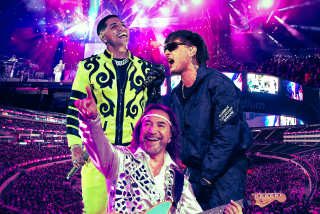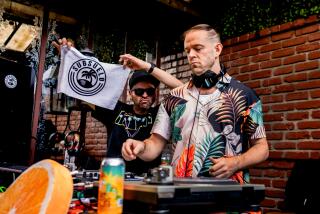At Sonic Crossroads
There’s an increasingly congested cultural intersection where hemp fashions mingle with microchips, where vegan burritos are washed down with enhanced smart drinks, where a ‘60s utopian love vibe blurs into a space-age utopian love vibe.
What are they dancing to at this crossroads? Very likely it’s the grooves of Sound Tribe Sector 9, a band that has locked into the inevitable mating of hippie and rave cultures.
Along with such acts as the Disco Biscuits, the New Deal, Lake Trout and L.A. newcomers Woven, the Bay Area-based STS9 has developed a hybrid of the improvisational jam-band aesthetic associated with the Grateful Dead and the clipped loops-and-samples rhythms of electronica.
This quintet’s brand of the sound--dubbed by some “organica”--may be the most natural of the bunch. There’s no deejay working samplers and sequencers on stage, just a basic guitar-bass-keyboards-drums ensemble fusing the styles, accompanied by a light show that blends Summer of Love trippiness with the sensory overload of rave visuals.
“We’re really joining the organic side of music with where technology is going,” bassist David Murphy says.
But the band, which plays Friday at the House of Blues in West Hollywood, had found some limitations to what it was doing and what the conjoined audiences expected. After forming in 1997 in Atlanta, STS9 earned a regional following on the Southeast college circuit. But the audience seemed to be leaning to one side of the equation, and the group felt it was getting into a bit of a rut.
“For a while it was definitely predictable,” says Murphy, 26. “We were drawing on more of a college crowd, kids who were following Phish. We started to break on the national scene just as Phish called a hiatus [in fall 2000]. We don’t sing, we stand there and jam for three hours, so it was very appealing to more of a jam-band audience.”
San Francisco
Proved Inspiring
Arguably, the band itself leans more toward the hippie side as well, with its candle-adorned stage sets and nods toward spirituality (the group’s name comes from a cycle in the Maya calendar). Still, in mid-2000, the STS9 members, whose ages range now from 23 to 31, packed up their gear and moved to San Francisco. Hippiedom’s mecca proved inspiring to the group as it sought to broaden its horizons and following.
Says Murphy: “Over the last year we’ve come back to putting more emphasis on the improvisation and getting back to the jazz roots and bringing computers on stage and getting into live sequencing--getting away from the looping side of things and really add computers and technology into a real-time, in-the-moment vibe.”
The band’s upcoming two-CD live album, “Seasons O1,” shows the first stages of the progress. Long pieces are built on slowly changing jazz-funk bass and percussion patterns, with Hunter Brown’s fluid guitar lines and David Phipps’ flights on Fender Rhodes and other tried-and-true keyboards recalling the early-’70s fusion experiments of Miles Davis.
Murphy doesn’t relate the band’s music to others in the jam world but feels more kinship with progressive jazz trio Medeski, Martin & Wood as well as techno-based artists DJ Spooky and Roni Size, who combine live performers with their samples-based music.
The audience is indeed expanding as the STS9 members had hoped it would.
“Over the last year and a half, especially in the bigger cities like San Francisco, L.A., New York and Atlanta, we’re seeing a more diverse crowd,” Murphy says. “There are older people, early 30s and late 20s, coming after work to see our shows, as well as an electronica fan base. It is a progression, and people need to understand that the music isn’t for just a hippie-band crowd.”
The band stands apart from the vast majority of acts in the thriving jam band wave, which still relies on solo showboating while talking a good game of collective creativity
“They don’t feature the virtuoso soloing that is the hallmark of the scene,” says Barry Smolin, producer and host of “The Music Never Stops,” a Friday evening radio show on KPFK-FM (90.7) devoted to the Grateful Dead and current jam bands. “And they’ve amassed a large following without the obnoxious self-promotion one encounters in other up-and-coming bands.”
Now STS9 is looking to expand its platform further. In addition to the House of Blues date, the band is playing several shows on the SnoCore Icicle Ball tour in March in an eclectic bill with jam favorite Karl Denson’s Tiny Universe and L.A. Latin/hip-hop ensemble Ozomatli, as well as the jam-centric High Sierra Festival during the July 4 weekend in Quincy, Calif. Most significant, it’s been booked for the well-rounded Coachella Music and Arts Festival, whose acts include Oasis, Bjork, Foo Fighters and the Chemical Brothers.
“Being at Coachella with rock, electronic and hip-hop, a more mainstream lineup--that’s kind of where we’re trying to go,” Murphy says.
And from there?
“We’ve discussed the concept of taking something on the road for six weeks or so almost along the lines of Cirque de Soleil,” he says. “To push ourselves musically to write a score of music totally in sync with other artists, that’s something we’d be more called to do, sit in a room with artists and dancers for weeks creating something. In some ways our music almost caters to that--free form, but structured.”
Sound Tribe Sector 9, Friday at the House of Blues, 8430 Sunset Blvd., West Hollywood, 9 p.m. $15. (323) 848-5100.
More to Read
The biggest entertainment stories
Get our big stories about Hollywood, film, television, music, arts, culture and more right in your inbox as soon as they publish.
You may occasionally receive promotional content from the Los Angeles Times.










